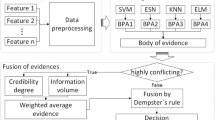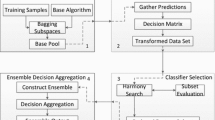Abstract
In ensemble learning, accuracy and diversity among classifiers are the keys to good integration. However, most diversity measures only evaluate the diversity of classifiers from a single point of view and have a poor correlation with the generalization capability of the final model. As such, there is still a lack of an effective diversity measure to guide the integration of classifiers. In this paper, an updatable fusion measure is proposed to evaluate diversity in classifiers. It is based on the evidential reasoning rule by fusing various measures from multiple perspectives. Before the fusion, the correlation among various diversity measures is tested. Only those measures with weak correlation can be fused. In addition, whenever a new effective measure appears, it can be fused with the old fusion measure after the significance test. Through the experimental verification of multiple data sets, classifiers, and combination strategies, this measure can effectively reflect the diversity of classifier combinations and assist classifier integration.







Similar content being viewed by others
Explore related subjects
Discover the latest articles, news and stories from top researchers in related subjects.References
Dietterich TG (1997) Machine learning research: four current directions. AI Mag 18(4):97–136
Zhou ZH, Wu J, Tang W (2002) Ensembling neural networks: Many could be better than all. Artif Intell 137(1–2):239–263
Sun B, Wang JD, Chen HY (2014) Diversity measures in ensemble learning. Control Decision 29(03):385–395
Jiang ZS, Liu HZ, Fu B (2019) Decomposition theories of generalization error and AUC in ensemble learning with application in weight optimization. Chin J Comput 042(001):1–15
Yang C, Yin XC, Hao HW (2014) Classifier ensemble with diversity: effactiveness analysis and ensemble optimization. Acta Automatica Sinica 40(004):660–674
Brown G, Wyatt J, Harris R (2005) Diversity creation methods: a survey and categorisation. Informat Fusion 6(1):5–20
Guo D, Jin Y, Ding J (2018) Heterogeneous ensemble-based infill criterion for evolutionary multiobjective optimization of expensive problems. IEEE Trans Cybernet 99:1–14
Pividori M, Stegmayer G, Milone DH (2016) Diversity control for improving the analysis of consensus clustering. Inf Sci 361–362:120–134
Jackowski K (2018) New diversity measure for data stream classification ensembles. Eng Appl Artif Intell 74:23–34
Jurek A, Hong J, Chi Y (2017) A novel ensemble learning approach to unsupervised record linkage. Informat Syst 71
Kuncheva LI, Whitaker CJ (2003) Measures of diversity in classifier ensembles and their relationship with the ensemble accuracy. Mach Learn 51(2):181–207
Liu H, Du Y, Wu Z (2019) AEM: attentional ensemble model for personalized classifier weight learning. Pattern Recogn 96:106976
Zhou G, Guo LF (2019) Process diversity measurement of ensemble learning based on information entropy. Comp Eng Sci 41(9):8
Tang EK, Suganthan PN, Yao X (2006) An analysis of diversity measures. Mach Learn 65(1):247–271
Li Y, Zhao M, Meng-Yao Xu (2019) A survey of research on multi-source information fusion technology. Intell Comput Appl. 9(5):4
Durrant-Whyte H, Henderson TC (2016) Multisensor data fusion[M]. Springer, Handbook of Robotics, pp 585–610
Zhu H, Basir O (2006) A novel fuzzy evidential reasoning paradigm for data fusion with applications in image processing[J]. Soft Comput 10(12):1169–1180
Wang H, Chen Y (2006) Sensor Data fusion using rough set for mobile robots system. IEEE/ASME International Conference on Mechatronic and Embedded Systems and Applications. 1–5.
Yang JB, Xu DL (2013) Evidential reasoning rule for evidence combination. Artif Intell 205(1):1–29
Tumer K, Ghosh J (1996) Analysis of decision boundaries in linearly combined neural classifiers. Pattern Recogn 29(2):341–348
Zhou ZH (2012) Ensemble methods: foundations and algorithms[M]. Taylor & Francis, China
Shipp CA, Kuncheva LI (2002) Relationships between combination methods and measures of diversity in combining classifiers. Informat Fusion 3(2):135–148
Yule GU (1900) On the association of attributes in statistics. Philos Trans Royal Soci A 194:257–319
Giacinto G, Roli F (2000) Design of effective neural network ensembles for image classification processes. Image Vision Comput J 19:699–707
Partridge D, Krzanowski WJ (1997) Software diversity: practical statistics for its measurement and exploitation. Inf Softw Technol 39(10):707–717
Jousselme AL, Grenier D (2001) A new distance between two bodies of evidence. Informat Fusion 2(2):91–101
Yang Y, Han DQ, Han CZ (2012) A difference measure of multi-classifier basedon evidence distance. J Aviat 33(006):1093–1099
Banfield RE, Hall LO, Bowyer KW (2003) A new ensemble diversity measure applied to thinning ensembles[C]. In: Proceedings of the 4th international workshop on multiple classifier systems. Berlin, Springer-Verlag, pp 306–316
Melville P, Mooney R (2003) Constructing diverse classifier ensembles using artificial training examples. In: Proceedings of the eighteenth international joint conference on artificial intelligence. Mexico, pp 505–510
Gao Q, Xu DL (2018) An empirical study on the application of the evidential reasoning rule to decision making in financial investment. Knowledge-Based Syst 164
Zhou M, Liu XB, Chen YW (2018) Evidential reasoning rule for MADM with both weights and reliabilities in group decision making. Knowledge-Based Syst 2018(143):142–161
Xu XB, Zheng J, Xu DL (2015) Information fusion fault diagnosis method based on evidential reasoning rule. Control Theor Appl 32(9):1170–1182
Tang SW, Zhou ZJ, Hu CH (2020) A new evidential reasoning rule-based safety assessment method with sensor reliability for complex systems. IEEE Trans Cybernet (99)
Zhao FJ, Zhou ZJ, Hu CH, Chang LL, Zhou ZG, Li GL (2016) A new evidential reasoning-based method for online safety assessment of complex systems. IEEE Transact Syst Man Cybernet 99:1–13
Martinez-Munoz G, Hernandez-Lobato D, Suarez A (2009) An analysis of ensemble pruning techniques based on ordered aggregation. IEEE Trans Pattern Anal Mach Intell 31(2):245–259
Acknowledgements
This work was supported in part by the Postdoctoral Science Foundation of China under Grant No. 2020M683736, in part by the Natural Science Foundation of Heilongjiang Province of China under Grant No. LH2021F038, in part by the innovation practice project of college students in Heilongjiang Province under Grant No. 202010231009, 202110231024, 202110231155, in part by the graduate quality training and improvement project of Harbin Normal University under Grant No. 1504120015, in part by the graduate academic innovation project of Harbin Normal University under Grant No. HSDSSCX2021-120, HSDSSCX2021-29
Author information
Authors and Affiliations
Corresponding author
Additional information
Publisher's Note
Springer Nature remains neutral with regard to jurisdictional claims in published maps and institutional affiliations.
Rights and permissions
About this article
Cite this article
Xu, C., Tang, SW., He, W. et al. An Updatable Classifier Diversity Measure Based on the ER Rule. Neural Process Lett 54, 4247–4263 (2022). https://doi.org/10.1007/s11063-022-10807-8
Accepted:
Published:
Issue Date:
DOI: https://doi.org/10.1007/s11063-022-10807-8




